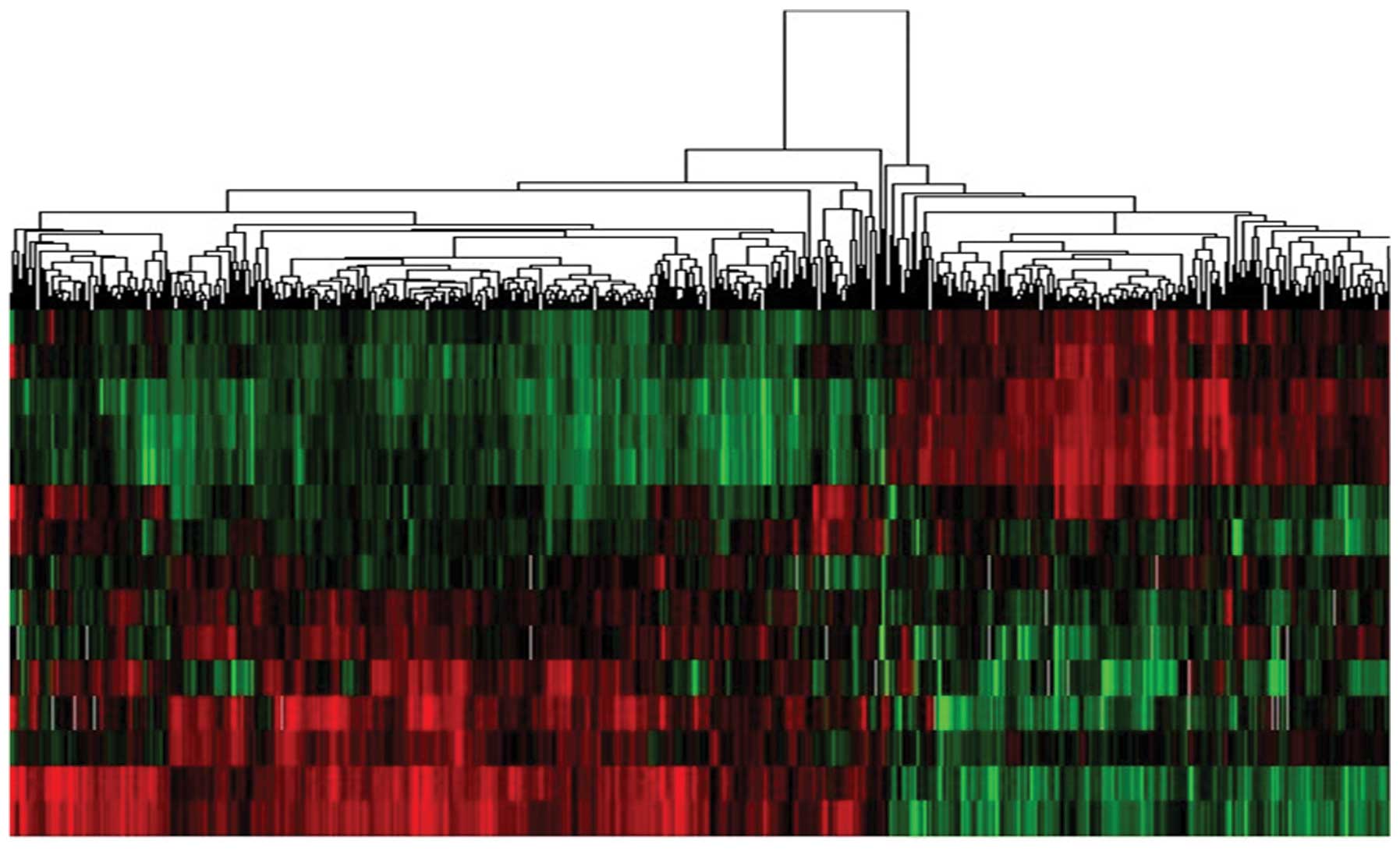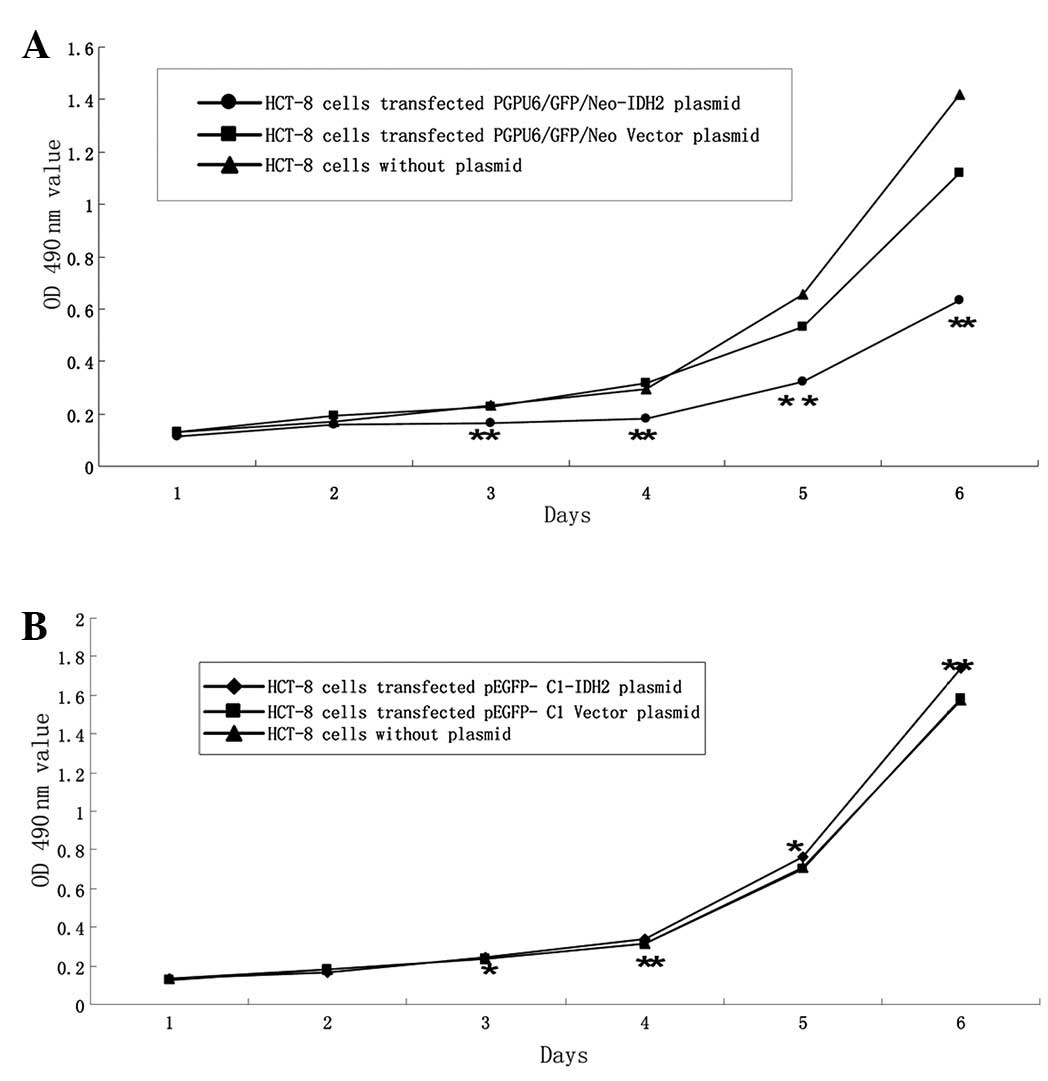|
1
|
Zhang YL, Zhang ZS, Wu BP and Zhou DY:
Early diagnosis for colorectal cancer in China. World J
Gastroenterol. 8:21–25. 2002.
|
|
2
|
Tischoff I and Tannapfel A: Epigenetic
alterations in colorectal carcinomas and precancerous lesions. Z
Gastroenterol. 46:1202–1206. 2008.(In German).
|
|
3
|
Zhang ZY and Zhao ZZ: Epidemiology of
colorectal cancer and future prospects. Cancer Res Prev Treat.
27:154–156. 2000.
|
|
4
|
Bonnet S, Archer SL, Allalunis-Turner J,
et al: A mitochondria-K+ channel axis is suppressed in
cancer and its normalization promotes apoptosis and inhibits cancer
growth. Cancer Cell. 11:37–51. 2007.PubMed/NCBI
|
|
5
|
Wolvetang EJ, Johnson KL, Krauer K, Ralph
SJ and Linnane AW: Mitochondrial respiratory chain inhibitors
induce apoptosis. FEBS Lett. 339:40–44. 1994. View Article : Google Scholar : PubMed/NCBI
|
|
6
|
Neuzil J, Wang XF, Dong LF, Low P and
Ralph SJ: Molecular mechanism of ‘mitocan’-induced apoptosis in
cancer cells epitomizes the multiple roles of reactive oxygen
species and Bcl-2 family proteins. FEBS Lett. 580:5125–5129.
2006.
|
|
7
|
Notarnicola M, Pisanti S, Tutino V, et al:
Effects of olive oil polyphenols on fatty acid synthase gene
expression and activity in human colorectal cancer cells. Genes
Nutr. 6:63–69. 2011. View Article : Google Scholar : PubMed/NCBI
|
|
8
|
Boss O, Hagen T and Lowell BB: Uncoupling
proteins 2 and 3: potential regulators of mitochondrial energy
metabolism. Diabetes. 49:143–156. 2000. View Article : Google Scholar : PubMed/NCBI
|
|
9
|
Brand MD, Affourtit C, Esteves TC, et al:
Mitochondrial superoxide: production, biological effects, and
activation of uncoupling proteins. Free Radic Biol Med. 37:755–767.
2004. View Article : Google Scholar : PubMed/NCBI
|
|
10
|
Casteilla L, Rigoulet M and Pénicaud L:
Mitochondrial ROS metabolism: modulation by uncoupling proteins.
IUBMB Life. 52:181–188. 2001. View Article : Google Scholar : PubMed/NCBI
|
|
11
|
Horimoto M, Resnick MB, Konkin TA, et al:
Expression of uncoupling protein-2 in human colon cancer. Clin
Cancer Res. 10:6203–6207. 2004. View Article : Google Scholar : PubMed/NCBI
|
|
12
|
Kuai XY, Ji ZY and Zhang HJ: Mitochondrial
uncoupling protein 2 expression in colon. World J Gastroenterol.
16:5773–5778. 2010. View Article : Google Scholar : PubMed/NCBI
|
|
13
|
King A, Selak MA and Gottlieb E: Succinate
dehydrogenase and fumarate hydratase: linking mitochondrial
dysfunction and cancer. Oncogene. 25:4675–4682. 2006. View Article : Google Scholar : PubMed/NCBI
|
|
14
|
Yan H, Bigner DD, Velculescu V and Parsons
DW: Mutant metabolic enzymes are at the origin of gliomas. Cancer
Res. 69:9157–9159. 2009. View Article : Google Scholar : PubMed/NCBI
|
|
15
|
Geisbrecht BV and Gould SJ: The human PICD
gene encodes a cytoplasmic and peroxisomal
NADP+-dependent isocitrate dehydrogenase. J Biol Chem.
274:30527–30533. 1999. View Article : Google Scholar : PubMed/NCBI
|
|
16
|
Fu YJ, Huang R, Du J, Yang R, An N and
Liang A: Glioma-derived mutations in IDH: from mechanism to
potential therapy. Biochem Biophys Res Commun. 397:127–130. 2010.
View Article : Google Scholar : PubMed/NCBI
|
|
17
|
Green A and Beer P: Somatic mutations of
IDH1 and IDH2 in the leukemic transformation of myeloproliferative
neoplasms. N Engl J Med. 362:369–370. 2010. View Article : Google Scholar : PubMed/NCBI
|
|
18
|
Reitman ZJ and Yan H: Isocitrate
dehydrogenase 1 and 2 mutations in cancer: alterations at a
crossroads of cellular metabolism. J Natl Cancer Inst. 102:932–941.
2010. View Article : Google Scholar : PubMed/NCBI
|
|
19
|
Ward PS, Patel J, Wise DR, et al: The
common feature of leukemia-associated IDH1 and IDH2 mutations is a
neomorphic enzymatic activity that converts α-ketoglutarate to
2-hydroxyglutarate. Cancer Cell. 17:225–234. 2010.PubMed/NCBI
|
|
20
|
Kang MR, Kim MS, Oh JE, et al: Mutational
analysis of IDH1 codon 132 in glioblastomas and other common
cancers. Int J Cancer. 125:353–355. 2009. View Article : Google Scholar : PubMed/NCBI
|
|
21
|
Sjöblom T, Jones S, Wood LD, et al: The
consensus coding sequences of human breast and colorectal cancers.
Science. 314:268–274. 2006.
|
|
22
|
Guirguis A, Elishaev E, Oh SH, Tseng GC,
Zorn K and DeLoia JA: Use of gene expression profiles to stage
concurrent endometrioid tumors of the endometrium and ovary.
Gynecol Oncol. 108:370–376. 2008. View Article : Google Scholar : PubMed/NCBI
|
|
23
|
Altenberg B and Greulich KO: Genes of
glycolysis are ubiquitously overexpressed in 24 cancer classes.
Genomics. 84:1014–1020. 2004. View Article : Google Scholar : PubMed/NCBI
|
|
24
|
Wang WZ, Guo X, Duan C, et al: Comparative
analysis of gene expression profiles between the normal human
cartilage and the one with endemic osteoarthritis. Osteoarthritis
Cartilage. 17:83–90. 2009. View Article : Google Scholar : PubMed/NCBI
|
|
25
|
Shin SW, Kil IS and Park JW: Silencing of
mitochondrial NADP +-dependent isocitrate dehydrogenase
by small interfering RNA enhances heat shock-induced apoptosis.
Biochem Biophys Res Commun. 366:1012–1018. 2008.PubMed/NCBI
|
|
26
|
Peng L, Yanjiao M, Ai-guo W, et al: A fine
balance between CCNL1 and TIMP1 contributes to the development of
breast cancer cells. Biochem Biophys Res Commun. 409:344–349. 2011.
View Article : Google Scholar : PubMed/NCBI
|
|
27
|
DeBerardinis RJ, Mancuso A, Daikhin E,
Nissim I, Yudkoff M, Wehrli S and Thompson CB: Beyond aerobic
glycolysis: transformed cells can engage in glutamine metabolism
that exceeds the requirement for protein and nucleotide synthesis.
Proc Natl Acad Sci USA. 104:19345–19350. 2007. View Article : Google Scholar
|
|
28
|
Berger F, Ramírez-Hernández MH and Ziegler
M: The new life of a centenarian: signalling functions of NAD(P).
Trends Biochem Sci. 29:111–118. 2004. View Article : Google Scholar : PubMed/NCBI
|
|
29
|
Belenky P, Bogan KL and Brenner C:
NAD+ metabolism in health and disease. Trends Biochem
Sci. 32:12–19. 2007.
|
|
30
|
Pollak N, Dölle C and Ziegler M: The power
to reduce: pyridine nucleotides - small molecules with a multitude
of functions. Biochem J. 402:205–218. 2007. View Article : Google Scholar : PubMed/NCBI
|
|
31
|
Xia Wl, Wang ZH, Wang Q, et al: Roles of
NAD+/NADH and NADP+/NADPH in cell death. Curr
Pharm Des. 15:12–19. 2009.
|
|
32
|
Ying W: NAD+/NADH and
NAD+/NADH in cellular functions and cell death:
regulation and biological consequences. Antioxid Redox Signal.
10:179–206. 2008.
|
|
33
|
Kim SY, Lee SM, Tak JK, Choi KS, Kwon TK
and Park JW: Regulation of singlet oxygen-induced apoptosis by
cytosolic NADP+-dependent isocitrate dehydrogenase. Mol
Cell Biochem. 302:27–34. 2007. View Article : Google Scholar : PubMed/NCBI
|














